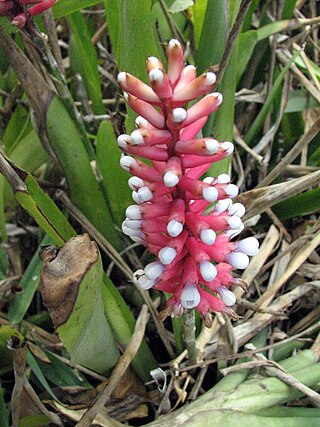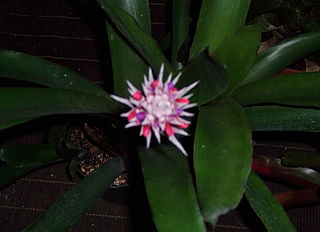
Aechmea bromeliifolia is a bromeliad native to southern Mexico, Central America, Trinidad, and South America as far south as northern Argentina.

Aechmea cylindrata is a bromeliad, native to southeastern Brazil from São Paulo to Santa Catarina. This plant is cited in Flora Brasiliensis by Carl Friedrich Philipp von Martius, and it is often used as an ornamental plant.

Aechmea fosteriana, the lacquered wine cup, is a bromeliad native to Brazil, which is endemic to coastal areas of the State of Espírito Santo. This plant is often grown as an ornamental plant.

Aechmea gamosepala is a bromeliad endemic to southern Brazil. It is often cultivated as an ornamental plant. This plant is cited in Flora Brasiliensis by Carl Friedrich Philipp von Martius
Aechmea perforata is a bromeliad native to Brazil, States of Bahia and Espírito Santo. This plant is often used as an ornamental plant.

Aechmea distichantha, the Brazilian vaseplant, or vase plant, is a bromeliad typical of Cerrado vegetation in Brazil, which is also native to northern Argentina, Bolivia, Paraguay, and Uruguay. This plant is often used as an ornamental plant.

Billbergia nutans, or Queen's-tears, is an epiphytic bromeliad native to Brazil, Paraguay, Uruguay, and Argentina.

Aechmea dealbata is a bromeliad in the subfamily Bromelioideae. This plant species has spiny green foliage with a complex pink and purple inflorescence. It is epiphytic but will grow in soil and is commonly cultivated. This species is endemic to the State of Rio de Janeiro in Brazil.

Aechmea mulfordii, the living vase bromelia, is native to the states of Pernambuco and Bahia in eastern Brazil. Most of the other plants in this genus are epiphytic, which means that they live up in the branches of the trees and exist mainly on the moisture and nutrients they obtain from the air. However, Aechmea mulfordii is a large terrestrial plant, growing near the sea level on sand dunes.

Aechmea coelestis is a species of flowering plant in the genus Aechmea. This is a species that is native to southeastern Brazil from Espírito Santo to Santa Catarina.
Billbergia decora is a species of flowering plant in the genus Billbergia. This species is native to Peru, Bolivia and Brazil.
Aechmea apocalyptica is a plant species in the genus Aechmea.

Aechmea aquilega is a plant species in the genus Aechmea. This species is native to Brazil, Venezuela, the Guianas, Trinidad, Jamaica and Costa Rica.
Aechmea caesia is a plant species in the genus Aechmea. This species is endemic to the State of Rio de Janeiro in Brazil.
Wittmackia canaliculata is a species of plant in the family Bromeliaceae. This species is endemic to the State of Bahia in Brazil.
Aechmea carvalhoi is a plant species in the genus Aechmea.
Aechmea discordiae is a species of flowering plant in the genus Aechmea. This species is endemic to the State of Bahia in eastern Brazil.
Aechmea glandulosa is a plant species in the genus Aechmea. This species is endemic to the State of Bahia in eastern Brazil.
Wittmackia linharesiorum is a species of plant in the family Bromeliaceae. This species is endemic to the State of Bahia in eastern Brazil.

Aechmea victoriana is a plant species in the genus Aechmea.















